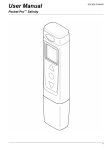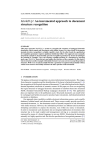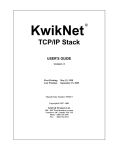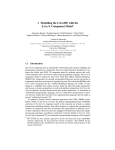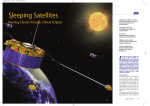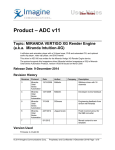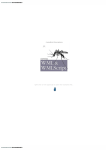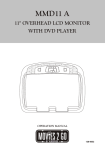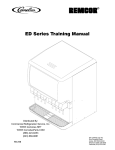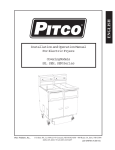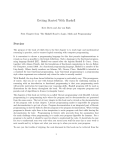Download RC 8059
Transcript
RC 8059 (#34988) 1/14/80
Computer Science
14 pages
Research Report
Exception Handling and Data Abstraction
Andrew P. Black
Programming Research Group, University of Oxford
and Thomas J. Watson Research Center, IBM Corporation
LIMITED DISTRIBUTION NOTICE
This report has been submitted for publication outside of IBM and w i l l probably be copyrighted if
accepted for publication. It has been issued as a Research Report for early dissemination of i t s
contents. I n view of the transfer of copyright t o the outside publisher, its distribution outside of I B M
prior t o publication should be limited t o peer communications and specific requests. After outside
publication, requests should be filled only by reprints or legally obtained copies of the article (o.~.,
payment of royalties).
---- ---- ----- -- --=
- ==-===
=-=
7
Research Division
San Jose Yorktown . Zurich
RC 8059 (#34988) 1 / 1 4 / 8 0
Computer Science
14 pages
Exception Handling and ~ a t Abstraction
a
Andrew P. Blackt
Programming Research Group, University of Oxford
and Thomas J. Watson Research Center, IBM Corporation
Abstract: A simple treatment of exception conditions in algebraic specifications is presented.
The method uses type unions and is also applicable to programs. The extensive use of unions is
not practical in many programming languages because of the verbose and baroque constructions
required to deal with them. Rather than introduce specialized facilities for exception handling
it is proposed that a simpler syntax be adopted for unions.
Key Words and Phrases: Abstract Data Types, Algebraic Specifications, Data Abstraction, Data
Types, Errors, Exceptions, Partial Operators, Type Unions, Unions, Variant Records.
C.R. Categories: 4.2, 4.22, 4.34.
t
Author's present address: Oxford University Computing Laboratory, 45, Banbury Road, Oxford, OX2 6PE, England
Exceptions a n d Data Abstraction
0 Introduction
A great deal has been written on the supposed difficulties of dealing with errors in
abstract data types, e.g., [ 5 I , [ 9 I , [ 6 I and [ 17 I. Some of the proposed solutions appear to
be very complicated. In this paper we retain simplicity by taking the view that there are n o
errors in an abstract data type.
Two situations which are often cited as errors are failure of an implementation and
production of an exceptional result. The first kind of error does not exist at all at the abstract
level; it resides solely in the implementation and so the question of how to deal with it in the
type definition never arises. Examples are attempting to represent the integers by fixed length
bitstrings or unbounded stacks by bounded arrays. W e do not consider such errors in this paper.
Of course, there is no reason why a designer should not axiomatize a restricted range of
integers or a stack with a maximum capacity if that is what he really wants. In doing so he may
need to define functions which produce exceptional results in certain circumstances, but such
results are certainly not 'errors'; on the contrary, they are exactly what is required.
To illustrate this point, consider the well known (unbounded) stack of integers. Application of the interrogation function T o p to such a Stack will usually yield an integer as the result.
However, application of T o p to the empty stack is exceptional in the sense that the result is
not an integer. Whether or not applying Top to an empty stack constitutes an error depends
entirely on what the routine using the stack abstraction does with the result of Top. If it
attempts to add 7 to the result then an error has occurred; on the other hand, if it tests the
result to see if the stack was empty then no error has occurred. Corresponding to the observation that only the way a result is used determines whether it is an error, we believe that it is
desirable to use the s a m e data type definition module in both of these situations. This implies
that the same specification be valid in both situations too.
This paper is divided into 6 sections. Section 1 describes the problem of specifying
types with exceptions. Section 2 uses an example to illustrate our proposed specification
technique and Section 3 describes the impact of this technique on programs, programming
languages and language implementations. Section 4 explores a mathematical background
consistent with these implementations. Section 5 is a brief survey of the history of exception
handling. Section 6 is the conclusion.
1 The Problem of Specifying Exceptions
We make no apology for drawing on the stack of integers as an example; simple as this
type is, a lot of the published specifications are either incomplete, overly complex or wrong.
Most definitions of stack contain an axiom along the lines of
Top(Empty) = EXCEPTION
where for EXCEPTION read variously UNDERFLOW, UNDEFINED, ERROR and so on. What
exactly does such an axiom mean? This is usually not at all clear.
In Guttag's Thesis [ 7 I the functionality of Top was described by
Top: Stack
->
Int.
This implies that EXCEPTION is an Int, which has some serious consequences. First, it is
counterintuitive, because as we noted above the result of Top(Empty) is not an Int - that is why
-2-
Exceptions and Data Abstraction
it is an exception. Second, every time we create a new data type such as Queueofint or
Stringo f i n t we are forced to add new exceptional elements to Int: in general, adding any new
type requires altering the definitions of all the types it uses, which is both impractical and
intellectually unappealing. Third, in doing this consistency problems arise in our axiomatization;
while there are several ways to resolve them much additional machinery is needed.
Our last point, the problem of consistency, deserves some elaboration; we present a
brief summary of the excellent exposition found in [6] Section 3.5. If EXCEPTION is an Int
then axioms must be given which explain the action of Int operations on it. The usual philosophy is to assure that once an exception occurs it is propagated, that is, if any argument of an
operation is EXCEPTION then so is its result.? If we attempt to implement this by simply
adding new axioms we rapidly run into trouble. W e must add rules like
Sum(n, EXCEPTION) = EXCEPTION
Product(EXCEPTION, n) = EXCEPTION.
(i)
(ii)
to the axiomatization of the integers. Of course, it still contains other rules describing the more
conventional properties, such as
(iii)
(iv)
Using the above four rules some interesting results can be obtained:
Product(EXCEPTION, 0 )
EXCEPTION
(by iv)
(by ii)
and
(by iii)
(by above)
(by i)
Sum(n, 0 )
Sum(n, EXCEPTION)
EXCEPTION
which show that all integers are equal to EXCEPTION. A similar problem arises within the
stack datatype; we must add a new constant STACK EXCEPTION of type stack and a new
axiom
Push(s, EXCEPTION) = STACK EXCEPTION
to ensure that errors propagate. In combination with the more usual axioms it is simple to show
that all stacks are equal to STACK EXCEPTION. This instance of the problem is dealt with
very fully in C 17I.
Of course, such problems can be resolved - various techniques are described in C 5 I,
C61 and C171. Our aim is not to criticize these mechanisms (indeed the mathematical
intricacies are such that we would find this difficult) but simply to observe that forcing the
result of Top(stack) to be an integer gives rise to serious problems which we would rather avoid.
More recently some authors (C8 I and C 10 I) have changed the problem by specifying
T o p as
Top: (Stack)
->
Int u {EXCEPTION}
Here again it is necessary to ask exactly what this means. We assume that the minor syntactic
change of placing the domain in parenthesis is meaningless; this notation, together with the use
of commas to denote a cartesian product, makes the specification more like most programming
t Another way of saying the same thing is to assert that all operations are strict in EXCEPTION .
Exceptions and Data Abstraction
-3-
languages. One possible interpretation for the right hand side, suggested when the word
UNDEFINED is used in place of EXCEPTION, is that Top is a partial function, i.e. it is defined
on some stacks only. In this case one might expect not to find any axiom giving the meaning of
Top(Empty), but then one could never be sure whether this was due to intention or oversight.
So an axiom Top(Empty) = UNDEFINED might reasonably be added to indicate that the
designer of the type had deliberately left the result of this application unspecified.
We will not pursue the use of partial functions any further, not because we doubt the
ability of mathematicians to produce a consistent theory but because we are interested in using
data types in programs. Being told that a program has an undefined result is not very useful;
what tends to happen is that different implementations define the result in different ways and
programmers become reliant on these local definitions. We should not forget that one of the
functions of type specifications is to help avoid such implementation dependence.
The interpretation that remains is the one that will be studied in this paper.
{EXCEPTION} denotes the datatype Exception (which has EXCEPTION as its only value) and u
denotes the union operation on datatypes. This interpretation also has its problems, but we feel
that they have simpler solutions than those discussed above. We go on to outline our approach
in more detail.
2 Axiomatic Specification of Exceptions
Figure 1 is our definition of Stackoflnt. We assume Bool to be a pre-defined type with
values TRUE and FALSE, and Union to be a pre-defined type schema which denotes datatype
union. W e use the term type schema (after the usage of mathematical logic, e.g., C 141) to
indicate that Union is a parameterized type definition, like Array or Set. (Indeed most frequently
Stack would be a type schema too, but we do not want to become involved with that here.) The
type Union[ta, tb] has operators Is[ta]: (Union[ta, tb]) -> Bool, From[ta]: (ta) -> Union[ta, tb]
and To[ta]: (Union[ta, tb]) + ta (and similarly for tb) representing inspection, injection and
projection respectively. The details of Union will be deferred to Section 4. This is because we
first wish to motivate our definition by showing how we expect Union to be used. In particular
we make no statement now about the result of To[ta] when applied to a union value that was
not formed from type ta.
T y p e StackofInt
Uses Underflow, Bool, Int
Operators
Empty: ( ) + StackofInt
Push: (Stackof Int, Int) + Stackof Int
Pop: (Stackof Int) -+ Stackof Int
Top: (Stackof i n t ) -> Union[Int, Underflow]
IsEmpty: (Stackof i n t ) -> Bool
Pop(Empty) = Empty
Pop( Push(s, i ) ) = s
Top(Empty) = From[Underf low](UNDERFLOW )
Top( Push(s, i) ) = From[Int](i)
IsEmpty(Empty) = TRUE
IsEmpty( Push(s, i ) ) = FALSE
Figure 1: Specification of StackofInt
Exceptions and Data Abstraction
-4 -
In using the names I s [ t a ] , From[ta] and T o [ t a ] we are inviting ambiguity between the
operators of the type Union[ta, tb] and those of the type Union[ta, tv]. We assume that this can
be resolved if necessary by qualifying the operator name with the type name, as in
Union[ta, tb].From[ta]. W e will not need to use this device in this paper because we will deal
with a limited number of types, but it introduces no new semantic issues.
The definition of stack shown in Figure 1 uses only total functions and yet avoids the
contradictions that troubled Majster [ 171. Pop( Push(S, Top(Empty)) ) is quite simply a
domain error. The result of Top(Empty) is a Union[Int, Underflow], which is clearly not of the
correct type to be used as the second parameter of Push, whose domain is Int. This is the kind
of error we consider in this paper: note that it is not an error in the datatype but in the use of
that type. Obtaining the result UNDERFLOW from T o p is an error if and only if the program
receiving that result was prepared to accept only integers. If it was prepared to find the stack
empty then no error has occurred, although the situation is still an exception in the sense that
the program will not perform the same operations on UNDERFLOW as it would have performed
on an integer.
3 Programming with Union Types
The ease with which the abstraction of Figure 1 may be implemented and the degree of
protection provided for the representation depend on the programming language used. Newer
languages generally recognize the need to construct new types from old by the use of union and
Cartesian product, to declare completely novel types by enumeration, to permit functions whose
results are of arbitrary type, to encapsulate data representations by prohibiting access by
functions other than the type operators, and so on. We intend to see how easy it is to define
operators returning results of union types in various languages. As far as possible we will ignore
the other facilities which aid or hinder the implementation of the rest of the type.
For the purposes of example we will concentrate on the function T o p . Since it will be
written only once, the ease of definition of T o p is less important than its ease of use. There are
two categories of use: one where the calling program is sure that the stack is not empty
(because some other reliable module has just told it so) and one where being empty is acceptable, indeed sometimes expected. Throughout this section stack and i are Stackofint and Int
variables respectivly.
In the first case, if the stack does indeed turn out to be empty then a real error has
occurred. Our reliable module is not as reliable as we thought! But this eventuality is not
something for which we should need to explicitly test; the burden of having to do that is
intolerable. We suggest that
be the syntax used in this case, and that the To[Int] operator have the following meaning. If the
type of its parameter is a Union with an Int component, and if the current value of the Union has
been injected from a value of type Int, then the result is that value. Otherwise, an error has
occurred. Whether that error is detected at compile-time or run-time is largely irrelevent and
depends on how much work the compiler does. Some errors one would obviously expect the
compiler to detect, a trivial example being the application of To[Int] to a Boo1 argument. On
the other hand, where the actual type of a union depends on input data the error cannot be
detected until run-time. W e expect that in any reasonable implementation the run-time system
will halt the program and produce a suitable error message, but we prefer to leave its choice to
the implementor. The statement i : = To[Int](Top(stack)) should thus be interpreted as a
message from the program writer to the program reader which says 'I know that stack is not
empty so I am making i the top integer'.
Exceptions and Data Abstraction
The second case is illustrated by the following example.
Printstack is
variable e is boo1
e := IsEmpty(stack)
i f -e d o
PrintInt(To[Int](Top(stack)));
stack : = Pop(stack);
PrintStack
if e do
Printstring('--bottom---)
endif
Here an explicit test of the state of the stack is made. Note that with the specification of
Figure 1 the function IsEmpty is redundant: the assignment e : = IsEmpty(stack) could be
replaced by e : = Is[Underflow](Top(stack)) without changing the semantics. Of course, this is
not true of a stack in which Top is a partial function: in that case IsEmpty is essential. Note
further that both Top and To[Int] can have exactly the same semantics as in the previous case;
we can be confident that no error will occur because of the way they have been used.
In what follows we will see how these two cases must be handled in various programming languages. The same examples will be treated and the reader is invited to make comparisons with the notation presented above.
Algol 68 provides a built-in type schema union which has some of the properties of our
Union. We may easily name a type (called a 'mode'), as in
mode IntOr Underf low = union(int, Underflow);
such a type can be used in exactly the same way as a primitive type. Note, however, that this
does not create a new type; it names an already existing one. There is no way to create new
types in Algol 68; in particular there is no way to create the enumeration type Underflow. In
practice we can be fairly confident that Underflow is distinct from other types by making it
name a record ('structure') with only one field which is selected by the name Underflow. Such a
structure is distinct from other structures with a different number of fields or a different
selector. The mode of the field cannot be void (which would be nice, as no storage would then
be allocated for it) so let us assume it is boo1 (which should waste the minimal amount).
mode Underflow = struct(boo1 Underflow)
In this particular example we could avoid the use of a distinct type Underflow altogether by
declaring
mode Underflow = void
but this would not be useful if more than one exception could occur. This is a consequence of
the rules for mode equivalencing. In the context of the declarations
mode Overflow = void;
mode Underflow = void;
mode StackResult = union(int, Underflow, Overflow)
the
mode StackResult is indistinguishable from union(int, void, void) and from
union(int, void). Thus such declarations would not enable one to distinguish between underflow
and overflow.
Exceptions and Data Abstraction
Very often there is useful additional information which an operation would like to
return when an exception occurs. In these cases declaring the exception types to be structures
does not waste storage but uses it. For example, a procedure which reads a string of digits from
an input stream might normally return an integer, but if a character other than a digit is found
the result might be a string. The mode union(int, B a d F o r m a t ) would be suitable for the result
of such an operator, where m o d e B a d F o r m a t = struct(string BadFormat).
In Algol 68, injection (i.e. the formation of a union value from a component value),
which we have indicated by using the From[ ] operators, is available as an implicit coercion. In
the right context, such as the result clause of a procedure delivering a union, a value of one of
the component types will be automatically 'united' to the required type. This provides the
briefest possible syntax with minimal loss of information or readability, because the type
required is always obvious from the context. In places where the context is not obvious it can
be made so by enclosing the expression in a 'cast', such as I n t O r U n d e r f low(Top(stack)). Thus it
is easy to write the Top operation in Algol 68. Unfortunately it is difficult to use it, because our
Is[ta] and To[ta] operations do not have simple counterparts. Instead there is a construction
called the 'conformity clause' which must be used even if the programmer knows the current
type of the union. Thus to perform the simple assignment appropriate to our first case we
would have to write
i :=
case Top(stack)
i n ( i n t result) :
result
, ( U n d e r f l o w ) : ( print ( Underflow found where Int expected1);
stop
1
esac.
This certainly makes clear what error action will be taken in the event that the type is not i n t ,
but we deem the need to specify this a disadvantage because we are looking for a construct to
use when the type is known to be right. The above is so verbose that one cannot really expect it
to be used every time the top integer of a stack is examined. The conformity clause is suitable
for use in the second case, when either an i n t or U n d e r f l o w is expected. The Printstack
example can be coded as
p r o c Printstack = v o i d :
case Top(stack)
i n ( i n t result) :
(
print(resu1t);
stack := Pop(stack);
Printstack
)
, ( U n d e r f l o w ) : print(11---bottom---)
esac.
It is possible to write operators equivalent to To[Int] and Is[Int] which simplify the first
example.
p r o c ToInt = ( I n t O r U n d e r f low iou) i n t :
case iou
i n (int i) :
i
, (Underflow) : (
print (I Underflow found where Int expected1);
stop
)
esac;
Exceptions and Data Abstraction
p r o c IsInt = ( I n t O r U n d e r f low iou) boo1 :
case iou
in (int) :
true
, (Underflow) : false
esac.
The problem is that similar procedures must be written for every component of every union,
and there is no 'procedure schema' mechanism in Algol 68 to help us produce them.
A similar, somewhat unsatisfactory, situation exists in Pascal. The problem is compounded by the need for Top to return a pointer to its result (functions may not return records)
and because the basically orthogonal mathematical concepts of union and Cartesian product
have been combined in a single linguistic construction, that is, the variant record.
The Pascal variant record is a structure containing an optional fixed part and a
variant part, which consists of a tag field of some enumerated type and several alternative
variants, one for each tag value. The intention is that only one of the variants should be current
and that its identity be given by the tag. An example is
t y p e symbol =
record
xloc, yloc : real;
area :real;
case s :shape o f
triangle :
(side : real;
inclination, anglel, angle2 :real );
rectangle : (sidel, side2, inclination : real);
circle :
(diameter :real)
end
As it stands this construction is not type-safe, for several reasons. The tag field is optional and
can in any case be assigned to independently of the rest of the record, indeed there is no way of
constructing a record without doing so. Thus, as Berry and Schwartz observe in C 1I , the
attitude of Pascal in this area is strictly caveat programmor (programmer beware). It is
possible to construct some functions which, if used as the only method of accessing variant
records, will prevent representation dependent results in the absence of parallelism. Figure 2
contains some samples. A significant improvement over Algol 68 occurs in the disassembly of
the variant record, where there is no need to introduce a case statement unless case analysis is
really required. Note that the ToInt function does not assign to IsInt if iou+.IsInt = false. This
is illegal, and one would expect the run-time system to produce an error. But it does not really
matter what happens: ToInt is only applied when we have already made certain that its
argument is an integer. W e will not deal more fully with Pascal because so many semantic
details are left unspecified by the Report [21 I that it is impossible to do so. Instead we will
take a look at Ada [ 12 I , [ 13I , which specifies its intentions more completely.
The Pascal-like confusion of product and union is still present in Ada. Type safety is
improved by making the tag-field (called a discriminant) a constant: it can be changed only by
updating the whole record. Components of the variant part are accessed by the dot notation; if
a component which does not exist is referenced the exception DISCRIMINANT-ERROR is
raised. Unfortunately it is possible to suppress this exception, thus breaching what would
otherwise be a strong typing system.
Ada does not have a facility powerful enough to permit the declaration of the Union
type schema as we have envisioned it. The possibility of 'generic' types is allowed, but only the
functionalities of the operators may be parameterized: we would like to parameterize the
names of the operators as well. In Ada we could indeed write an instantiation
p a c k a g e IntOrUnder f low is n e w Union(Integer, Underflow)
Exceptions and Data Abstraction
type
Underflow = (UNDERFLOW);
IntOr Underf low = 4 Intor Underf 1owRecord;
IntOrUnderf lowRecord = record case IsInt :Boolean o f
true : (Int : integer);
false :()
end;
f u n c t i o n FromUnderf low ( u : Underflow) :IntOrUnderf low;
war result :IntOrUnderf low;
b e g i n new(resu1t);
result4.IsInt : = false;
FromUnderf low : = result
end;
f u n c t i o n FromInt ( i : integer) :IntOrUnderf low;
war result :Intorunder f low;
b e g i n new(resu1t);
result4.IsInt : = true;
result\.Int : = i;
FromInt : = result
end;
f u n c t i o n IsInt (iou :IntOrUnderf low) :Boolean;
b e g i n IsInt : = iou4.IsInt
end;
f u n c t i o n ToInt (iou :IntOrUnderf low) : integer;
b e g i n i f iou4.IsInt
t h e n ToInt : = iou4.1nt
else writeln( ' Underflow found where Int expected ' )
end;
Figure 2: Pascal routines to encourage use of unions
but the operators would have to be called things like IsTypel and ToType2, which is hardly
satisfactory.
The Ada version of the type definition is shown below.
t y p e IntOrUnderf low is
record
IsInt : c o n s t a n t Boolean;
case IsInt o f
w h e n true => Int :integer;
w h e n false => n u l l ;
e n d case;
e n d record:
Values of this type are constructed explicitly using record aggregates such as
(IsInt +. true, Int +. 17) and (IsInt +. false) (using the named selector notation). Since the
type of such aggregates is not obvious we may chose to define conversion operators FromInt and
FromUnderf low; samples are given in Figure 3.
Assignment of a union to an integer variable is accomplished by component selection.
However, the syntax does not permit the direct application of selection to the result of a
function: it is necessary to use an intermediate variable of type IntOrUnderf low. Assuming iou to
Exceptions and Data Abstraction
function Fromint (i : integer) return IntOrUnderf low is
begin return (IsInt +. true, Int +. i )
end;
function FromUnderf low ( u : Underflow) return IntOrUnderf low is
begin return (IsInt +. false)
end;
Figure 3: Ada routines for constructing union values
be such a variable one may write
iou : = Top(stack);
i : = iou.Int
- M a y raise DISCRIMINANT-ERROR
There is no obvious reason for the proscription of the more direct Top(stack).Int. It is certainly
a breach in orthogonality and probably arises through oversight. Nevertheless, the inconvenience of having to introduce a temporary name (which must be declared at the top of a 'unit',
not where it is needed) is such that one will probably want to define a ToInt operator.
An interesting question now arises as to whether such an operator can be considered an
Ada function. It is not a mathematical function because it does not always return a value: if its
argument is not formed from an integer it raises an exception instead. Additionally, such
operators do not preserve commutativity as required by C 13I Section 7.4. However, the raising
of an exception is not one of the things disallowed in a function body. Indeed, the language
definition C 12 1 states that if an invocation of a function does not cause a return statement to
be executed then the exception NO-VALUE-ERROR is raised. It also gives an example of a
function containing an assert statement, which raises an exception if the assertion is false. The
basic problem is that handling exceptions by jumping is an operational concept and does not
have a place in functional programming. For the purposes of our example we will follow the
letter rather than the spirit of the Ada definition and write
function ToInt (iou :IntOrUnderf low) return integer is
begin return iou.Int -- M a y raise DISCRIMINANT-ERROR
end.
Of the languages discussed so far, Ada is the only one which provides facilities for
encapsulating the definition of a data type. By this we mean that it provides a linguistic
construction behind which the representation of a type may be concealed whilst other operations on it are exposed. Thus Ada supports data abstraction more specifically than does Algol 68
or Pascal.
There are a whole host of data abstraction languages which pre-date Ada. W e will look
at only one, the programming language CLU C 16 I , C 15 I . We will not study the data abstraction facilities because that is not the main subject of this paper. We will examine the way
unions are treated.
CLU has a basic type schema called the oneof which creates an object which is one of a
set of alternatives. It was not designed as an exception handling mechanism; there are extensive
(separate) features for exception handling. A one0f type has the form
oneof [11 : T l , 12: T y
... , l n : T ]
where the li are labels ('tags') and the T i are types. All the li must be distinct, but this is not
required of the Ti. This overcomes the problem of creating unique types present in Algol 68;
one0f [Integer : int, Underflow : null, Overflow : null1 is useful because it is possible to tell
- 10 -
Exceptions and Data Abstraction
whether a value nil (of type null) indicates Underflow or Overflow. This type is also distinct
from another oneof with fields of the same types but with different labels. A oneof is not a
true union because oneof C i: int, b: one0f C i : int, b: boo11 I cannot be simplified; it is not, for
example, the same as one0f [ i: int, b: boo11 .
Oneof objects must be created explicitly: for each tag li there is a constructor
) which takes an argument of type Ti. Taking a oneof apart is more difficult. It is
necessary to use a tagcase statement; this is similar to the Algol 68 conformity clause except
make_l.(
that the choice is made according to the tag rather than the type. Thus, although CLU makes it
easy to create the types which are needed to handle exceptions through unions, it does not offer
appropriate constructions and syntaxes to use them for this purpose.
W e conclude this section on programming by summarizing the properties a language
should have in order to facilitate the use of unions to handle exceptions. It should be easy to
create new types which cannot be confused with existing types. It should be easy to construct
types which are unions of other types; the operations of creating values of the union and
projecting such values back into the appropriate type must be possible without syntactic
verbosity. The language should not insist on the use of case analysis unless there are cases to
analyse. If there is no built in union type schema with these properties then there should be a
type parameterization mechanism sufficiently powerful to create one. None of these requirements need compromise efficiency or type safety.
4 A Mathematical Basis for Union
In order to have made any advance on previous work we must state exactly what is
meant by our type definitions using Union, which means giving a semantics for Union. Figure 4 is
an attempt to provide an axiomatic specification of Union.
t y p e Union[ta : Type, tb : T y p e ]
uses Bool
Operators
Is[ta] :(Union[ta, tb]) ->- Bool
Is[tb] :(Union[ta, t b ] ) ->- Bool
From[ta] : (ta) -> Union[ta, tb]
From[ta] : (tb) -> Unionha, tb]
To[ta] : (Union[ta, t b ] )-> ta ...
To[tb]: (Union[ta, t b ] ) -> tb ...
Is[ta]( From[ta](a)) = true
Is[ta]( From[tb](b) ) = false
Is[tb]( From[ta](a)) = false
Is[tb]( From[tb](b) ) = true
To[ta](From[ta](a)) = a
To[ta](From[tb](b)) = ...
To[tb](From[ta](a)) = ...
To[tb](From[tb](b)) = b
Figure 4: Partial Specification of Union
As the ellipses indicate,
this specification
is incomplete.
An application
To[tb]( From[ta](a) ) is clearly a type error and we would expect a program containing it to halt
and say so. The usual way of accommodating this in a functional semantics is to define the
result of such a misapplication to be (bottom), the totally undefined value, and to ensure that
Exceptions and Data Abstraction
all operations in the language are strict in L , i.e. f(-lJ = L for all operations f . Now it is
indeed correct for a program to halt when it encounters T o [ t b ] ( From[ta](a) ). Since this
expression evaluates to i, the whole computation must evaluate to i. It is unnecessary to
perform any further applications: one can simply stop and say that the answer is L .
The requirement that every operation be strict in i means that L must be in the
domain and range of every operation. This can be ensured by implicitly adding ' U i' to both
sides of all the functionalities in our specifications. To the axioms we implicitly add f ( L ) = L
for all operators f . Note that we cannot use Union to extend the functionalities because making
1 into a type, say Bottom, would mean that Is[Bottom]( F r o m [ B o t t o m ] ( ~ )) = true where
strictness requires that it should be i. In accordance with this convention we can complete the
above specification by deleting the ellipses after T o [ t a ] and To[tb] in the list of functionalities
and replacing them by i in the axioms.
It may be argued with some justification that using i to represent the result of an
erroneous application is not very satisfactory. One would be even more justified in complaining
about its use to denote a non-terminating computation. To rectify these faults requires a slightly
more complicated set of domains in our semantic theory. But in a real language To[ ] will not
be the only operator requiring such embellishments for its complete formal definition. It seems
reasonable to define T o [ 1 with the same degree of rigour as the rest of the language. We do
not intend to dictate here what this should be. What is important is that the ordinary programmer should know exactly what the operators of Union will do.
It may seem that in leaving open exactly how to specify the exceptional cases of the
T o [ ] operators we have left the original problem unsolved. This is not so. We started with the
problem of finding a simple way of dealing with exceptions in user defined data types. This
problem has been reduced to that of dealing with exceptions in one type, and one which is built
into the programming or specification language. And that problem is not new; it has been with
us ever since we began to attempt the rigorous definition of languages.
The conventional interpretation of a data type is that it defines a set of values, i.e. each
value belongs to exactly one type. It is clear that we must be very careful to avoid the paradoxes of set theory if we wish to treat types as values, which is the natural way of dealing with type
parameters [ 191. That is why we have preferred to speak of Union as a type schema rather
than as a function t y p e x t y p e ->Â type; the usual interpretation of a schema is by syntactic
substitution.
Recently there has been some interesting work on types as sets of operations [ 3 1, [ 2 1.
The underlying value space is considered to be untyped and there is no fundamental problem in
dealing with types as values: the paradoxes mentioned above are avoided. Another advantage of
this approach is that it is closely related to the way in which values are dealt with in real
implementations. In a computer a value is an untyped string of bits whose i n t e r p r e t a t i o n
depends on the type of the operators used to examine it. Although this formalization is still a
research topic it offers hope of providing a rigorous semantics for languages with type definition
facilities.
5 A Historical Perspective
The problem of handling exceptions is not a new one to programming, nor is it confined
to operators implementing data abstractions. An example as old as Fortran is a routine which
searches an array A for a number x and if it is found returns an index i such that A [ i ] = x. The
exceptional case of x not being found was traditionally indicated by the return of 0 or some
other value not valid as an index into A.
Exceptions and Data Abstraction
This is indeed a reasonable solution in a language like Algol 60 or Fortran in which it is
not possible to indicate the range of the search function beyond saying that that the result will
be an integer. In Pascal it is possible to specify that the range is exactly the same as the
subscript domain of A, and it is advantageous to do so because it makes the intention of the
program clearer to both human readers and the compiler. The latter may then use a more
compact representation for the result and avoid inserting the run-time checks that would
otherwise be necessary when the result is used to index an array. These advantages are lost if
the range of the function is extended to include even one value which is not a valid index, and
that is exactly what we are doing if we add 0. What is needed is some mechanism for indicating
explicitly that 0 is a an exceptional value not intended as an index and that only values in 1..n
will be used in this way. What the proposal of Section 3 amounts to is just such a mechanism:
instead of writing the result type as O..n we advocate writing Union[NotFound, l . . n ] . It is
reasonable to expect the compiler to notice that only the l . . n component is used as an index and
to elide tests accordingly. Thus the proposal of this paper represents nothing new: it is merely
the translation of a well known technique into a notation compatible with specific typing.
Another historically significant method of dealing with exceptions was common in the
days of assembly code. When a routine detected an exceptional condition it did not return
normally at all; it either stopped with an error message or made an abnormal return. For
example, the standard return point for a subroutine call might be to a place two instructions
after the call; a return to the instruction immediately following the call would indicate an
exception. A different way of achieving a similar effect is to pass as a parameter an address to
which the exceptional return should be made. This can be programmed in Algol 60 where
non-local labels may be passed as parameters. Use of these techniques has declined as the
dangers of non-local and dynamic jumps and routines with multiple exits became widely
appreciated and languages which restricted such facilities were developed. There has been a
recent reversal of this trend with the appearance of languages like CLU, Mesa C 4 I C 18 I and
Ada which attempt to promote such jumps to the status of a high level feature. The exception
handling in CLU is by far the simplest of the three; it nevertheless gives rise to what is by far
the most involved part of the semantics C 20 I . Experience with Mesa, which has a much more
complicated exception mechanism, has shown that it confounds readability and reliability C 111.
It is still too early to evaluate exception handling in Ada as a formal definition has yet to be
published and there is no experience with its use. However, examination of the manual C 12 I
gives one cause for concern. The global nature of exceptions violates the principle of locality
that has been maintained in the rest of the language. The way an exception will be handled in
the multi-tasking environment does not even seem to be deterministic. One can only hope that
things will turn out to be better than they appear.
6 Conclusion
The method of dealing with exceptions proposed in this paper avoids all the difficulties
mentioned above. It does this by achieving a separation of concerns. All exceptions are
confined to the Union type schema, leaving the programmer free to create libraries of data types
and operators whose semantics can be stated by simple axioms.
The ease of use of this technique depends to some extent on how willing one is to allow
implicit conversions. In the example i : = To[Int](Top(stack) it might be reasonable for the
To[Int] to be syntactically omissible. The context here is such that a compiler could quite easily
insert it. Although such abbreviations can be attractive they can also give rise to misunderstanding. Whether they should be allowed, and if so in which contexts, could be the subject of
another paper. The considerations are human rather than mathematical; it may turn out that
the place to insert the coercions is not in the compiler but in the editor used to construct the
program text. This paper aims to provide a semantic base on which such syntactic shorthands
can be built.
Exceptions and Data Abstraction
- 13 -
Our method involves certain changes in style which some programmers may be
reluctant to make. At first our way of handling exceptions may seem strange. We have used it
to program the example given in [ 151 Section 12.3, in which many exceptions occur at
different levels. With suitable defaults we find the use of unions produces more readable code
than exception handlers. The reader is invited to try some examples himself. As a bonus there
is no exception handling scheme to understand, and data types defined using unions can be
specified with the simplest axiomatic technique.
Acknowledgements
This paper was written while on leave at the IBM T. J. Watson Research Center,
Yorktown Heights, New York; the support of IBM Corporation and IBM World Trade Corporation are gratefully acknowledged.
The author wishes to thank J. W. Thatcher and C. A. R. Hoare for constructive
comments on an earlier draft of this paper. R.-D. Fiebrich has helped improve the presentation
in many ways.
References
Berry, D.M. and Schwartz, R.L. United and discriminated record types in strongly typed languages.
Processing Letters 9, 1 (July1979) pp 13-18
Inf.
Demers, A. and Donahue. J. Revised report on Russell T R 79-389 Department o f Computer Science, Cornell
University. (September 1979) pp 42
Donahue, J. On the semantics o f 'Data Type' SIAM J . Comput. 8, 4 (November 1979). pp 546-560
Geschke, C.M., Morris J.H. Jnr. and Satterthwaite, E.H.
(August 1977). pp 540-553
Early experiences with Mesa.
Comm. ACM 20, 8
Goguen, J.A. Abstract errors for abstract data types. Formal Description of Programming Concepts. (Neuhold,
E J . , Ed.) North Holland (1978). pp 491-525
Goguen, J.A., Thatcher J.W. and Wagner, E.G. An initial algebra approach to the specification, correctness and
implementation o f abstract data types. Current Trends in Programming Methodology Volume IV: Data
Structuring (Yeh, R.T., Ed.) Prentice Hall (1978).pp 80-149
Guttag, J.V. The specification and application t o programming o f abstract data types. Ph.D. Thesis - Computer
Systems Research Group Report CSRG-59. Department o f Computer Science, University o f Toronto. (September
1975). pp 154
Guttag, J.V., Horowitz, E., Musser D.R. Abstract data types and software validation. ISI/RR-76-48 University
o f Southern California Information Sciences Institute. (August 1976). pp 45
Guttag, J.V., Horowitz, E., Musser D.R. Some extensions t o algebraic specifications. Procs of an ACM
Conference on Language Design for Reliable Software (Wortman, D.B. Ed.) North Carolina (March 1977)
pp 63-67
~ u t t a J.V.,
~ ; Horowitz, E., Musser D.R. The design o f data type specifications. Current Trends in Programming Methodology Volume IV: Data Structuring. (Yeh, R.T., Ed.) Prentice Hall (1978).pp 60-79
Horning, J.J. Language features for fault tolerance. Lecture Notes on Computer Science 69: Program
Construction International Summer School. (Bauer, F.L. and Broy, M., Eds.) Springer-Verlag (1977).
pp 508-512
Ichbiah, J.D. et al. Preliminary Ada reference manual. SIGPLAN Notices 14, 6 Part A (June 1979).
Ichbiah, J.D. et al. Rationale for the design o f the Ada programming language. SIGPLAN Notices 14, 6 Part B
(June 1979).
Kleene, S.C. Mathematical Logic. Wiley, New York (1967).
Liskov, B.H., Moss, E., Schaffert, C., Scheifler, R.W. and Snyder, A. CLU Reference Manual. Computational
Structures Group Memo 161. Massachusetts Institute o f Technology, Laboratory for Computer Science. Draft
(July1978). pp 138
Liskov, B.H., Snyder, A., Atkinson, R. and Schaffert, C . Abstraction mechanisms in CLU. Comm. ACM 20, 8
(August 1977).
564-576
ip
Exceptions and Data Abstraction
- 14 -
[17] Majster, M.E. Treatment of partial operations in the algebraic specification technique. Proceedings Specifications of Reliable Software IEEE (1979). pp 190-197
[18] Mitchell, J.G., Maybury, W. and Sweet R. Mesa Language Manual. Technical Report CSL-78-1. Xerox Palo
Alto Research Centre (1978).
[I91 Reynolds, J.C. Towards a theory of type structure. Lecture Notes in Computer Science 19: Programming
Symposium. (Robinet, B, Ed.) Springer-Verlag (1974). pp 408-425
[20] Scheifler, R.W. A Denotational Semantics of CLU. M.S. Thesis - MlT/LCS/TR-201. Massachusetts Institute
of Technology, Laboratory for Computer Science. (May 1978). pp 175
[21] Wirth, N. Revised report on the programming language Pascal. Pascal User Manual and Report. (Jensen, K .
and Wirth, N) Eleventh printing. Springer-Verlag (1979). pp 133-167
















